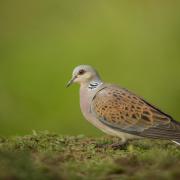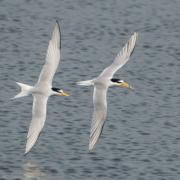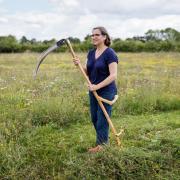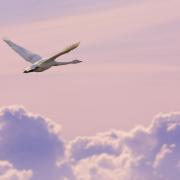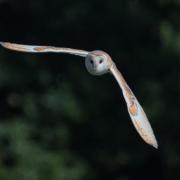Blink and you’ll miss him – the hare is twice as fast as the swiftest man on earth. Wildlife writer Andrew Fallan finds much to celebrate about Suffolk’s own brown hares

With its long, black-tipped ears and proud athletic physique, its chiselled features, blazing amber eyes and gorgeously grizzled coat, the brown hare is undoubtedly one of the UK’s most beautiful, charismatic and iconic wild animals.
Unbeknown to many, it is also our fastest land mammal, reaching speeds of up to 45 mph and capable of a 100-metre sprint in a mere five seconds – almost twice as fast as current world record holder Usain Bolt.
And with a rich history of folklore trailing in its wake, clinging to every turn and jink as it races across the open countryside, it’s also fair to say that the hare is part of the very fabric of these isles.
Suffolk is quite a special place for hares. A mere stone’s throw from the coastal village of Orford lies the RSPB’s Havergate Island, where these remarkable animals have no natural fear of humans and are therefore quite obliging, making for some quite special encounters. The island itself nestles within the River Alde on the landward side of Orford Ness, whose shifting pebbles form the largest shingle spit in Europe and a remote, weather-beaten wilderness on the edge of the North Sea.
Amid the Ness’s broad, desert-like plain, the resident hares are but one species among an array of wildlife that has successfully reclaimed this heavily spoiled former military test site, which is now managed by the National Trust.
Just inland from these coastal treasures are Suffolk’s sprawling arable flatlands. This lush rural landscape provides a stronghold for these long-eared, long-limbed denizens of field and farmland, who, unlike rabbits, live their entire lives above ground, their only protection – together with the cover of grasses and crops – a small, shallow scrape in the ground known as a ‘form’.
Hares are best known for providing us with one of nature’s great spectacles. Although usually solitary, they will sometimes come together in pairs or small groups, whereupon, as if in response to some deep inner stirring, the mayhem begins.
Amid a flurry of madcap chasing and scurrying, two or more individuals will square up to each other on hind legs and, in a frenzy of fur-tufts and flailing paws, start to ‘box’ – often quite viciously. Once thought to be frisky males competing for the attentions of the female, these feverish bouts are, in fact, the result of a reluctant female, also known rather colourfully as a Jill, fighting off the amorous advances of any number of males, known as Jacks.
Contrary to popular belief, boxing is not limited to spring but actually occurs all year round. But the notion of the ‘Mad March Hare’ is not entirely without foundation, as their celebrated fisticuffs do reach a climax in March. Coincidentally, crops are relatively low to the ground, making the hares more conspicuous.
Although having undoubtedly found their way into the nation’s affections, these charismatic creatures are under serious threat, joining the ranks of some of our most beleaguered species. The overall number of brown hares has fallen by more than 80% over the last 100 years, with agricultural intensification a major factor in their dramatic decline. In some parts of the UK they may have disappeared altogether.
Quite apart from the fact that their speed, agility and split-second manoeuvrability make them targets for the now illegal activity of hare coursing, as a so-called game animal that is considered an agricultural pest hares have scant legal protection. They are also the only British game species without a shooting ‘close season’, meaning they can be legally killed at all times of the year. Large shoots in East Anglia during late winter and early spring can account for numbers that equate to around 40% of the national population, and while the species as a whole might be able to recover from these huge losses, there are significant welfare implications for such an early breeder, as the orphaned young, known as leverets, are left to starve. Many hares, which have a habit of lying low when threatened, fall victim to farm machinery and pesticides.
So, as well as sparing a thought for the threats and hardships that hares face, next time you’re out and about amid the rolling fields and sweeping coasts of Suffolk, keep your eyes peeled for that most British of mammals, the endlessly alluring brown hare. Who knows, with a bit of patience you may even be lucky enough to witness one of our most celebrated, most treasured and most spellbinding wildlife spectacles – and one that will hopefully be a feature of our countryside for generations to come.
n Andrew Fallan is the author of Winging it – Birding for low-flyers and also writes a regular column for Essex Life magazine on the wildlife of the county.


















